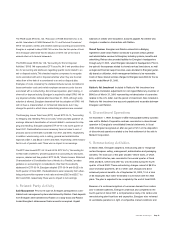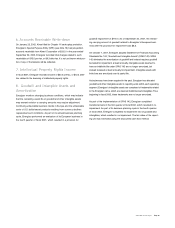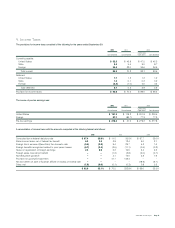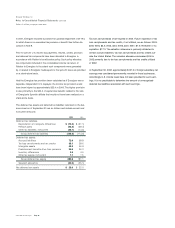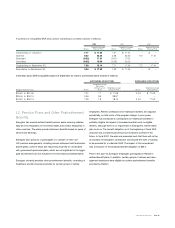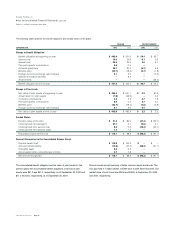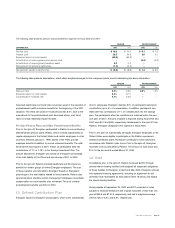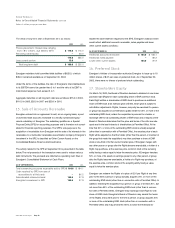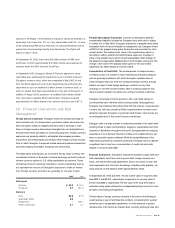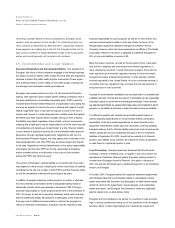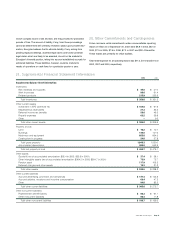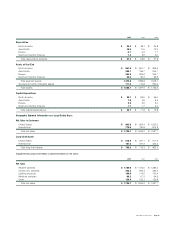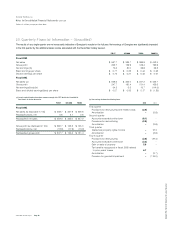Energizer 2002 Annual Report Download - page 39
Download and view the complete annual report
Please find page 39 of the 2002 Energizer annual report below. You can navigate through the pages in the report by either clicking on the pages listed below, or by using the keyword search tool below to find specific information within the annual report.
ENR 2002 Annual Report Page 37
The following table presents pension and postretirement expense for fiscal 2002 and 2001:
PENSION POSTRETIREMENT
SEPTEMBER 30, 2002 2001 2002 2001
Service cost $ 16.6 $ 16.6 $ 0.1 $ 0.2
Interest cost 26.5 24.5 3.6 6.1
Expected return on plan assets (48.9) (46.9) – –
Amortization of unrecognized prior service cost – – (2.4) (0.3)
Amortization of unrecognized transition asset 0.3 0.3 – –
Recognized net actuarial (gain)/loss (1.3) (3.3) – –
Net periodic benefit cost/(income) $ (6.8) $ (8.8) $ 1.3 $ 6.0
The following table presents assumptions, which reflect weighted-averages for the component plans, used in determining the above information:
PENSION POSTRETIREMENT
2002 2001 2002 2001
Discount rate 6.2% 6.6% 6.5% 7.0%
Expected return on plan assets 8.3% 8.7% ––
Compensation increase rate 4.7% 5.2% ––
Assumed healthcare cost trend rates have been used in the valuation of
postretirement health insurance benefits for the beginning of the 2001
valuation. The trend rate used for those periods was 6.5%. Due to the
amendment to the postretirement plan discussed above, cost trend
rates no longer materially impact the plan.
Pre-Spin Pension Plans and Other Postretirement Benefits
Prior to the spin-off, Energizer participated in Ralston’s noncontributory
defined benefit pension plans (Plans), which covered substantially all
regular employees in the United States and certain employees in other
countries. Effective January 1, 1999, assets of the Plans provide
employee benefits in addition to normal retirement benefits. The addi-
tional benefit was equal to a 300% match on participants’ after-tax
contributions of 1% or 1.75% to the Savings Investment Plan. The
amount allocated to Energizer was based on Energizer’s percentage
of the total liability of the Plans and was income of $2.1 in 2000.
Prior to the spin-off, Ralston provided healthcare and life insurance
benefits for certain groups of retired Energizer employees. The cost
of these benefits was allocated to Energizer based on Energizer’s
percentage of the total liability related to these benefits. Ralston also
sponsored plans whereby certain management employees could defer
compensation for cash benefits after retirement. The cost of these
postretirement benefits was $3.3 in 2000.
13. Defined Contribution Plan
Energizer sponsors employee savings plans, which cover substantially
all U.S. employees. Energizer matches 50% of participants’ before-tax
contributions up to 6% of compensation. In addition, participants can
make after-tax contributions of 1% of compensation into the savings
plan. The participant’s after-tax contribution is matched within the pen-
sion plan at 325%. Amounts charged to expense during fiscal 2002 and
2001 were $4.0 and $3.8, respectively. Subsequent to the spin-off from
Ralston, Energizer charged $1.8 to expense in fiscal 2000.
Prior to the spin-off, substantially all regular Energizer employees in the
United States were eligible to participate in the Ralston-sponsored
defined contribution plans. Participant contributions were matched in
accordance with Ralston’s plan terms. Prior to the spin-off, Energizer
recorded costs as allocated by Ralston. The amount of such costs was
$1.2 for the six months ended March 31, 2000.
14. Debt
Immediately prior to the spin-off, Ralston borrowed $478.0 through
several interim-funding facilities and assigned all repayment obligations
of those facilities to Energizer. In April and May 2000, Energizer entered
into separate financing agreements, including an agreement to sell
domestic trade receivables as discussed in Note 15 below, and repaid
the interim-funding facilities.
Notes payable at September 30, 2002 and 2001 consisted of notes
payable to financial institutions with original maturities of less than one
year of $94.6 and $110.3, respectively, and had a weighted-average
interest rate of 3.8% and 6.9%, respectively.


